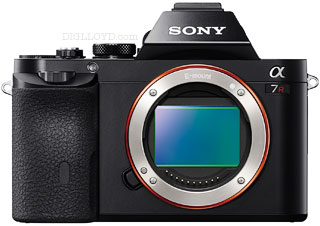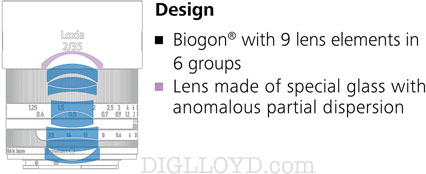Zeiss Loxia: Manual Focus All Metal Build Lenses for Mirrorless Full Frame

Sony Alpha A7S / A7 / A7R
(and others)
Pre-Order Zeiss Loxia lenses at B&H PHoto.
The two new Zeiss Loxia lenses incorporate proven Zeiss designs into all-metal manual focusing lens bodies for the full-frame Sony Alpha A7/A7R system.
These are the lenses I would choose as a Sony A7s/A7/A7R shooter for most of my purposes (particularly the A7s, for video focusing). Why? Because I like the solidity and long-lasting build quality along with the precision of manual focus (180° focus throw). A good manual focus feel/throw is a wonderful thing, and the EVF on the Sony bodies makes pinpoint focus easy and fast.
Note that it is possible to choose on the fly a clicked or declicked aperture feature, a first AFAIK (declicked is ideal for video shooters).
Other appealing points include weather sealing and the all-metal barrel, though it’s not clear to me what prevents ingress of water at the front end, since the inner barrel presumably has to move in out with focusing.
ZEISS Loxia lenses are designed for use in normal conditions. The Loxia lenses are not fully protected against splash water, nor are they water-proof. However, the lens mount features dust and weather proofing. Additional protection against extraordinary environmental influences is not provided. They do not feature protection in accordance with the ISO IP standard. These lenses are designed for use at temperatures ranging from -20°C to +55°C.
I’ll be testing the Loxia lineup later this fall when press samples become available. Because these are for mirrorless, review coverage will be in Guide to Mirrorless. Zeiss DSLR lenses for Canon and Nikon are covered in Guide to Zeiss, and Zeiss ZM rangefinder lenses are covered in Guide to Leica.
With both lenses, bear in mind that actual performance on a digital sensor depends not just on the lens by itself, but the lens design as optimized (or not) for the sensor cover glass thickness and ray angle. The sensor cover glass and ray angle issue is why Leica M lenses often fare poorly on Sony mirrorless. And its why performance of the Loxia line has to be evaluated with real images, not via comparison with other MTF charts. Zeiss has surely accounted for these factors so as to ensure that the designs will perform well on Sony mirrorless, by tweaking the optics slightly. That this is so is easily seen in the outstanding results with the 35/2 Biogon on the Sony RX1R, which compares favorably and maybe even outperforms the famed Leica Summilux 35/1.4.
Zeiss Loxia 35mm f/2 Biogon
Both lens designs are classics, and are presumably tweaked to be optimal for ray angle issues and sensor cover glass on the Sony A mirrorless lineup (support for other brands presumably will follow, when other brands like Fujifilm offer a full frame camera).
The 35mm f/2 Biogon originates as rangefinder lens design (Zeiss ZM 35mm f/2 Biogon for use on Leica M). This is the superb lens design used in the Sony RX1 / RX1R (lovely performer there), though it could incorporate modifications for A7s/A7/A7R system.

The front element of the Zeiss Loxia 35mm f/2 Biogon of a special glass type (presumably to control various color aberrations), but it’s unclear if this differs from the RX1R or ZM designs. My guess is that it is new to the Loxia design versus the ZM lens, at least.

Zeiss Loxia 50mm f/2 Planar
The 50mm f/2 Planar is another classic Zeiss design, presumably based on the Zeiss ZM 50mm f/2 Planar for Leica M. It is a very strong performer when stopped down slightly, and has gorgeous bokeh from its symmetric design.

Marketplace positioning
The main question that arises in my mind is the strategic approach: it’s a courageous move to go manual focus and high quality build in today’s market, and that will attract a certain group of customers on its own.
The marketplace risk as I see it relates to optical performance and pricing relatively close to alternatives. These designs are excellent, but for many users autofocus exerts a strong pull. So some icing on the cake would add appeal: I would like to see something more on the optical front, meaning aggressive efforts towards wide open image quality. Certainly Zeiss Otus quality is out of the question (size/weight/price), but heading strongly in that direction. A higher price point (double) would be needed to meet that goal, but many of the potential customers would find that an appealing tradeoff, and it would establish a clearly separate category. As it stands the Loxia pricing at around $1000 seems to me as a customer to carry the same risks as the Touit line.
Zeiss Loxia Press release
Manual focusing, manual aperture and maximal image quality
With the new Loxia 2/35 and Loxia 2/50 lenses, ZEISS combines maximum image quality with classic ease of use for E-mount full-frame cameras.
OBERKOCHEN, September 2, 2014
The ZEISS lenses Loxia 2/35 and Loxia 2/50 are the first members of a new family of manual focus lenses for the E-mount full frame. They are optimized for digital sensors and electronic viewfinders and feature a mechanical aperture setting and the mechanical deactivation of the click stop (de-click) for ambitious videography. But these are just a few of the highlights. The lenses will be presented to the public for the first time at ZEISS’s booth at photokina in Cologne from September 16 to 21, 2014.
“Ever since the Sony Alpha 7/7r/7s helped compact system cameras break through to the full frame, there has been a growing desire for a ‘digital manual focus‘ experience that combines the best of both worlds. The Loxia 2/35 and Loxia 2/50 are the first members of a new family of manual focus lenses for the E-mount full frame. By entering this field, ZEISS not only wants to meet this desire, but exceed it,” said Christophe Casenave, Product Manager with ZEISS Camera Lenses.
Freedom of composition in photography was the guiding principle in developing the ZEISS Loxia 2/35 and ZEISS Loxia 2/50. An electronic interface transmits lens data (EXIF), but it also recognizes focus movements and, if desired, activates the camera’s magnifier function. This supports the possibilities of modern compact camera systems with an electronic viewfinder. Furthermore, the Loxia lenses allow for precise manual focusing as well as a mechanical setting of the aperture (aperture priority). This traditional way of working expresses one’s personal photo lifestyle, opening up surprising creative possibilities to compose the image that go beyond all automation.
It is not for nothing that compact camera systems are one of the most interesting developments on the photography market today. Many photographers also appreciate the combination of traditional principles of handling and operation with the most modern technology.
Yet another highlight – the mechanical deactivation of aperture click stops (de-click), thus creating progressive and noiseless aperture settings– makes this new lens family a tool that provides a high degree of creative potential, not only for photographers but also for ambitious videographers. Thanks to their precise manual focusing, the Loxia 2/35 and Loxia 2/50 are also suitable for professional video productions.
The Loxia lens family has been specially optimized for digital sensors. The optical design of the Loxia 2/35 is based on a Biogon and consists of nine lens elements in six groups. With a full-frame focal length of a moderate wide angle, this lens is particularly well suited for nature, landscape and architectural photography. Its creative potential also comes to the fore thanks to its low minimum object distance of 0.3 meters, which allows close-ups with an unusual perspective.
The design of the Loxia 2/50 is based on a Planar and has six lens elements in four groups. As a ‘classic’ normal lens with a full-frame focal length of 50 millimeters, it offers photographers a field of view that corresponds to natural eyesight. The Loxia 2/50 is ideally suited for a wide range of situations, from travel photography, family photography and photojournalism to portraiture – and with a minimum working distance of 0.37 meters it is suitable for close-ups, too. The Loxia 2/50 is an uncomplicated but at the same time high-quality standard lens that photographers can keep on their camera continuously, therefore allowing them to react flexibly to a wide range of everyday situations.
Both Loxia lenses have a high speed of f/2, which expands the creative possibilities even more. Two examples are the effective isolation of motifs with a low depth of field or free-handed photography, even with poor lighting conditions.
The Loxia lens range intentionally eschews autofocus. This makes them compact and ideal for travel and street photography. Photographers who work in these fields often do not like to be recognized right away as professionals. The Loxia lenses offer a high resolution across the entire image field and a harmonious bokeh in the background, especially at the maximal aperture opening of f/2. The Loxia family stands out for its superb mechanical quality. The smooth focus operation with a large focus rotation angle of approximately 180 degrees allows for the finest variations in focusing. The filter diameter is a consistent M52 across the entire lens family. The robust barrel is made completely of metal so that it can withstand the rough everyday situations that professional photographers face and ensuring a long product life. In addition, the lenses have a special weather sealing at the lens mount to prevent spray water from getting between the camera and the lens.
The Loxia 2/50 will be available worldwide starting October 2014 and the Loxia 2/35 from the end of the fourth quarter of 2014. The recommended retail price of the Loxia 2/35 will be EUR 965.55* (US$ 1,299.00)* and that of the Loxia 2/50 will be EUR 713.45* (US$ 949.00)*.
For more information, visit www.zeiss.com/photo.


























